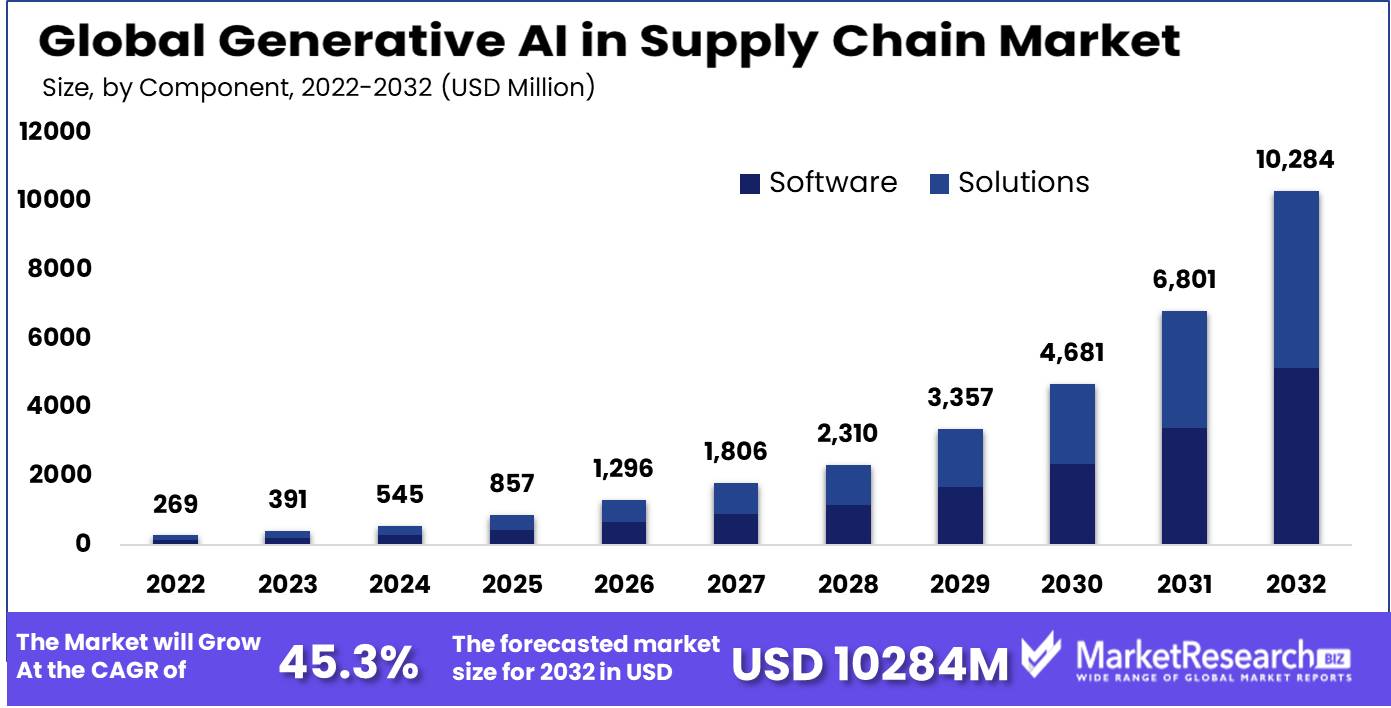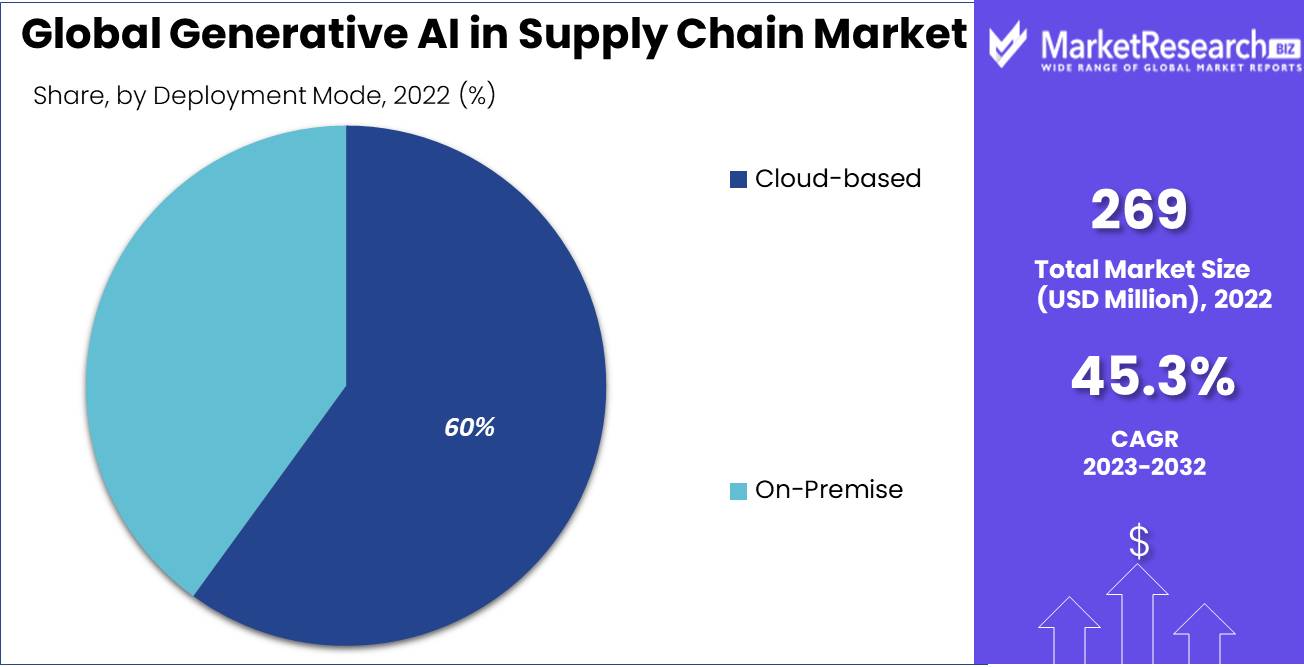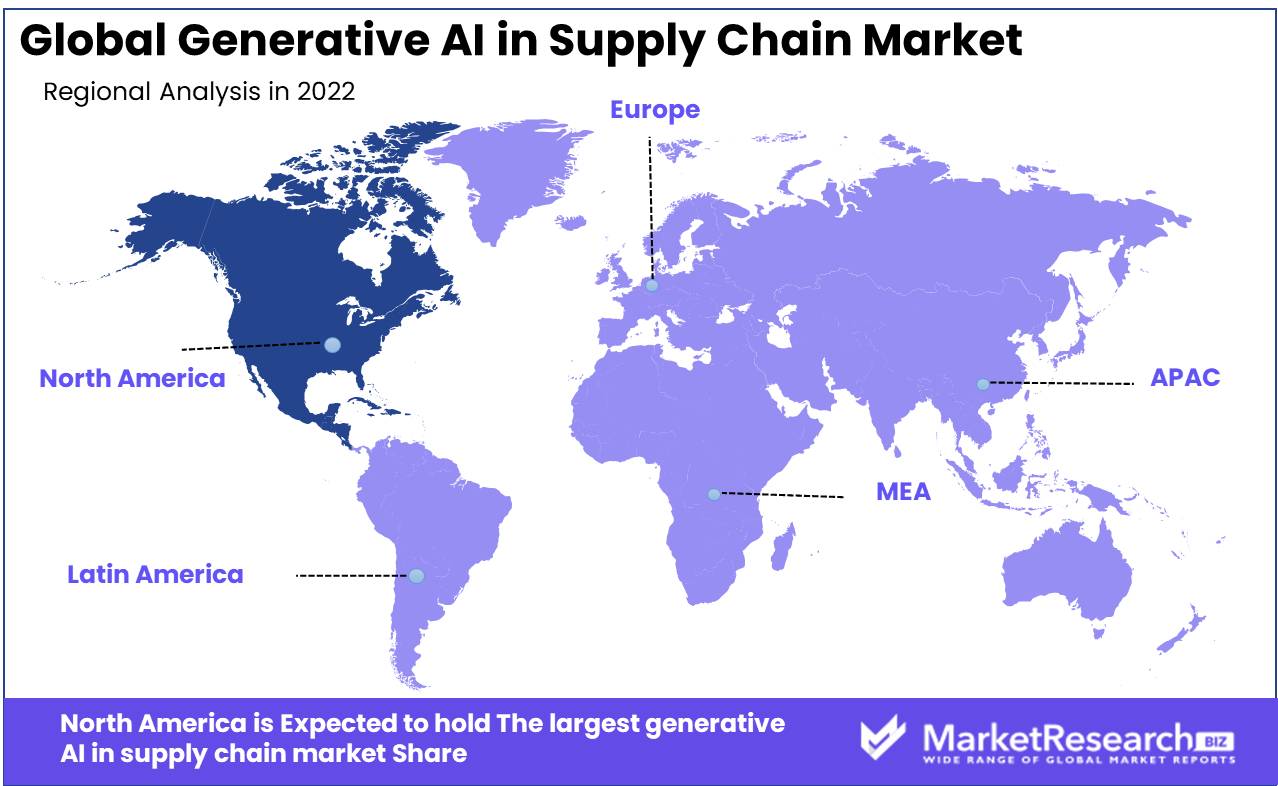
Global Generative AI in Supply Chain Market By Component (Solutions and Software), By Deployment Mode (Cloud-based and On-Premise), By End-User (Retail, Manufacturing, Healthcare, and Other End-Users), By Region and Companies - Industry Segment Outlook, Market Assessment, Competition Scenario, Trends, and Forecast 2023-2032
-
36886
-
July 2023
-
155
-
-
This report was compiled by Correspondence Linkedin | Detailed Market research Methodology Our methodology involves a mix of primary research, including interviews with leading mental health experts, and secondary research from reputable medical journals and databases. View Detailed Methodology Page
-
Report Overview
Global Generative AI in Supply Chain Market size is expected to be worth around USD 10,284 Mn by 2032 from USD 269 Mn in 2022, growing at a CAGR of 45.3% during the forecast period from 2023 to 2032.
Utilizing machine learning algorithms to produce fresh, original outputs based on already-existing data inputs is known as generative AI. The production, distribution, and delivery of goods and services are all handled through a complex network of organizations, assets, processes, and information known as the supply chain. It includes many phases, including manufacturing, logistics, and customer service. To optimize operations, cut costs, and satisfy consumer needs, firms must manage the supply chain effectively. Because it can analyze huge datasets, spot patterns, and produce insights and solutions, generative AI has attracted a lot of attention lately. Generative AI can be used in the supply chain to boost efficiency by streamlining procedures and enhancing decision-making.

Number might vary in actual report
Market Scope
Component Analysis
Based on components, generative AI in supply chain market is segmented into solutions and software. Among these types, both segments have lucrative in the global generative AI in supply chain market. Solutions typically refer to comprehensive packages or platforms that incorporate various software components to provide end-to-end generative AI capabilities for supply chain optimization, demand forecasting, inventory management, and other related tasks. On the other hand, software specifically focuses on the computer programs and algorithms used to develop and deploy generative AI models in the supply chain domain.
These software solutions may include machine learning libraries, data processing tools, optimization algorithms, and other software components required to build and operate generative AI systems. The dominance of either segment can vary depending on market dynamics, technological advancements, and specific business requirements.
Deployment Mode Analysis
By deployment mode, the generative AI in supply chain market is further divided into cloud-based and on-premise. The cloud-based segment is estimated to be the most lucrative segment in the global generative AI in supply chain market. Cloud-based deployment has gained significant popularity in recent years due to its advantages such as scalability, flexibility, ease of implementation, and reduced infrastructure costs. Cloud-based solutions leverage remote servers and computing resources to process and analyze large volumes of data, making them well-suited for organizations with dynamic needs, limited IT resources, or a preference for outsourcing infrastructure management.
On-premise solutions involve installing and managing generative AI software and infrastructure within the organization's own data centers or servers. This approach offers greater control over data and infrastructure but may require higher upfront investments, increased maintenance efforts, and limited scalability compared to cloud-based alternatives.

Number might vary in actual report
End-User Analysis
Based on end-user, the generative AI in supply chain market is segmented into Retail, Manufacturing, Healthcare, and Other End-Users. Generative AI is transforming supply chain operations across various industries, empowering businesses to make data-driven decisions, enhance efficiency, and deliver better customer experiences. The retail sector is a significant end-user of generative AI in supply chain market. Retailers are leveraging generative AI technologies to optimize inventory management, demand forecasting, and supply chain logistics.
The healthcare sector is increasingly adopting generative AI in supply chain to improve patient care and optimize operations. AI algorithms can assist healthcare providers in managing medical inventory, tracking medical equipment, and optimizing supply chain logistics. The Other End-User category includes various industries such as logistics, transportation, agriculture, and energy.
Key Market Segments
Based on Component
- Solutions
- Software
Based on Deployment Mode
- Cloud-based
- On-Premise
Based on End-User
- Retail
- Manufacturing
- Healthcare
- Other End-Users
Market Dynamics
Drivers
By analyzing massive datasets, finding patterns, and producing insights to improve operations, generative AI aids organizations in managing this complexity. For supply chain management to be successful in the fast-paced business climate of today, real-time decision-making is essential. By analyzing and processing enormous volumes of data in real-time, generative AI enables businesses to assist rapid decision-making throughout the supply chain.
The capabilities of generative AI in the area of supply chains have increased thanks to the quick development of AI and machine learning technology. Utilizing generative AI for complicated supply chains is now viable because of improved algorithms, more powerful computers, and improved data analytics methods.
Restraints
The availability of high-quality and diverse datasets is crucial for generative AI. It might be difficult to gather and integrate pertinent data from multiple sources along the supply chain, though. A generative AI algorithm's performance and accuracy can be negatively impacted by incomplete or erroneous data, producing less-than-ideal results.
Large amounts of sensitive data, including those about customers, suppliers, and operational data, must be handled while using generative AI. A crucial concern is ensuring data privacy and upholding the security of this information. Businesses may face legal issues and reputational damage as a result of data breaches or improper handling.
Opportunity
To produce precise demand estimates, generative AI models can analyze historical data, industry patterns, and other pertinent aspects. Supply chain managers can use this to reduce stockouts, increase overall supply chain efficiency, and optimize inventory levels. Various scenarios and their potential effects on the supply chain can be simulated by generative AI models. Organizations can proactively create contingency plans to reduce risks and boost resilience by taking into account situations like supplier disruptions, market volatility, or natural disasters.
By creating a variety of prototypes depending on provided criteria, generative AI can help with product design. This can facilitate modification to fit unique consumer needs while also speeding up the design process and lowering costs. Considering variables like distance, traffic, delivery windows, and vehicle capacity, generative AI algorithms can optimize delivery routes.
Trends
The supply chain landscape is changing as a result of the digital revolution. To automate operations, increase visibility, and improve decision-making, businesses are implementing technologies like the Internet of Things (IoT), cloud computing, blockchain, and artificial intelligence (AI). E-commerce's expansion has increased the demand for effective omnichannel fulfillment. To support same-day delivery, direct-to-consumer orders, and seamless customer experiences across different channels, supply chain networks are being optimized.
Generative AI in Supply Chain Market, sustainable practices are becoming more and more important. To satisfy environmental goals and customer expectations, businesses are introducing eco-friendly efforts including reducing carbon footprints, using responsible sourcing practices, reducing waste, and adopting circular economy ideas.
COVID-19 Impact Analysis
The pandemic has caused substantial fluctuations in consumer demand for different products. Generative AI algorithms trained on historical data may struggle to accurately predict demand patterns during the pandemic due to the unprecedented and volatile nature of the market. Supply chain systems relying on generative AI models may face challenges in adjusting to sudden shifts in demand, leading to issues such as overstocking or understocking of goods. With supply chain disruptions and uncertain demand, effective inventory management has become crucial.
Generative AI can assist in optimizing inventory levels and improving demand forecasting. However, the pandemic has introduced additional complexities, such as the need to account for perishable goods, expiration dates, and shifting customer preferences. Adjustments to generative AI models may be required to handle these unique considerations.
Regional Analysis
North America is estimated to be the most lucrative market in the global generative AI in supply chain market. The United States possesses a substantial presence in AI research and development as well as the global supply chain. The nation hosts major technology firms, research institutions, and innovative startups that drive progress in generative AI for supply chain applications. In Europe, there exists a robust AI research community with a strong emphasis on supply chain management.
Countries like Germany, the United Kingdom, and France have taken the lead in AI advancements within the region. European companies actively investigate generative AI applications to improve supply chain operations and logistics efficiency. It is worth noting that generative AI is a swiftly evolving field, and its potential in the supply chain is currently being explored and developed by organizations and researchers worldwide.

Number might vary in actual report
Key Regions
- North America
- The US
- Canada
- Mexico
- Western Europe
- Germany
- France
- The UK
- Spain
- Italy
- Portugal
- Ireland
- Austria
- Switzerland
- Benelux
- Nordic
- Rest of Western Europe
- Eastern Europe
- Russia
- Poland
- The Czech Republic
- Greece
- Rest of Eastern Europe
- APAC
- China
- Japan
- South Korea
- India
- Australia & New Zealand
- Indonesia
- Malaysia
- Philippines
- Singapore
- Thailand
- Vietnam
- Rest of APAC
- Latin America
- Brazil
- Colombia
- Chile
- Argentina
- Costa Rica
- Rest of Latin America
- Middle East & Africa
- Algeria
- Egypt
- Israel
- Kuwait
- Nigeria
- Saudi Arabia
- South Africa
- Turkey
- United Arab Emirates
- Rest of MEA
Market Share & Key Players Analysis
Emerging key players in the global generative AI in supply chain market are adopting diverse strategic approaches to enhance their business presence in international markets. Many companies are prioritizing the expansion of their existing operations and research and development (R&D) facilities. Additionally, players in the generative AI supply chain market are actively involved in developing new products and expanding their portfolios through investments, mergers, and acquisitions. Moreover, several key players are placing increased emphasis on marketing strategies aimed at raising awareness about the benefits of generative AI in optimizing supply chain processes, thereby fueling the growth of their offerings.
Market Key Players
- IBM Corporation
- Microsoft Corporation
- SAP SE
- Oracle Corporation
- Blue Yonder
- LLamasoft Inc
- AIMMS
- Other Key Players
Recent Developments
- IBM offers the Sterling Supply Chain Suite, which integrates various AI technologies, including generative AI, to optimize supply chain operations. The suite includes capabilities for demand forecasting, inventory optimization, order management, and supplier collaboration, among others.
- IBM Watson Supply Chain Insights is a solution that leverages AI and machine learning techniques, including generative AI, to provide end-to-end visibility and insights into supply chain operations. It helps organizations identify patterns, predict disruptions, and optimize decision-making for better supply chain performance.
- Microsoft's Project Bonsai aims to democratize AI and make it accessible to subject matter experts, including those in the supply chain domain. While the focus of Project Bonsai is broader than just generative AI, it provides tools and capabilities for developing intelligent systems that can optimize complex processes and decision-making in supply chain management.
Report Scope:
Report Features Description Market Value (2022) USD 269 Mn Forecast Revenue (2032) USD 10,284 Mn CAGR (2023-2032) 45.30% Base Year for Estimation 2022 Historic Period 2016-2022 Forecast Period 2023-2032 Report Coverage Revenue Forecast, Market Dynamics, COVID-19 Impact, Competitive Landscape, Recent Developments Segments Covered By Component - Solutions and Software; By Deployment Mode -Cloud-based and On-Premise; By End-User - Retail, Manufacturing, Healthcare, and Other End-Users Regional Analysis North America – The US, Canada, & Mexico; Western Europe – Germany, France, The UK, Spain, Italy, Portugal, Ireland, Austria, Switzerland, Benelux, Nordic, & Rest of Western Europe; Eastern Europe – Russia, Poland, The Czech Republic, Greece, & Rest of Eastern Europe; APAC – China, Japan, South Korea, India, Australia & New Zealand, Indonesia, Malaysia, Philippines, Singapore, Thailand, Vietnam, & Rest of APAC; Latin America – Brazil, Colombia, Chile, Argentina, Costa Rica, & Rest of Latin America; Middle East & Africa – Algeria, Egypt, Israel, Kuwait, Nigeria, Saudi Arabia, South Africa, Turkey, United Arab Emirates, & Rest of MEA Competitive Landscape IBM Corporation, Microsoft Corporation, SAP SE, Oracle Corporation Blue Yonder, LLamasoft Inc, AIMMS, Other Key Players
Customization Scope Customization for segments, region/country-level will be provided. Moreover, additional customization can be done based on the requirements. Purchase Options We have three licenses to opt for: Single User License, Multi-User License (Up to 5 Users), Corporate Use License (Unlimited User and Printable PDF) -
-
- IBM Corporation
- Microsoft Corporation
- SAP SE
- Oracle Corporation
- Blue Yonder
- LLamasoft Inc
- AIMMS
- Other Key Players




